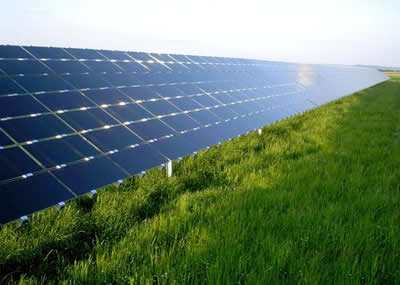BLOG
By Yasha Husain, posted May 14, 2009
Debate #2: Green Energy in the American Southeast
1.45 MW thin film solar park in field
Photo Courtesy of Beck Energy/National Renewable Energy Laboratory
Bioenergy and biomass
Photo Courtesy of National Renewable Energy Laboratory
Nate Blair, Senior Analyst/Group Manager at National Renewable Energy Laboratory (NREL) in Colorado
Input from Nate Blair, a Senior Analyst/Group Manager at NREL, is regarding which renewable energy sources look most likely to be tapped in the southeast in the coming years. His emailed response was sent on April 20th:
The southeastern states have a set of renewable resources that are less obvious than the southwestern US (strong solar) or the Midwest (wind dominates). However, with New Jersey being the 2nd largest builder of solar PV systems in the country (after CA) but minimal solar resource, the southeastern states shouldn’t dismiss renewables due to their resource levels. Obviously, one can make either wind or PV work in the southeast but it’s just more costly because the resource might not be as good.
My expectation would be that the dominant renewable resource for electricity would be biomass power (with carbon capture added eventually). Second, I would expect PV systems to be a significant contributor in the southeast. CSP is a more difficult proposition because CSP can only use “direct radiation” or “DNI” and not “diffuse radiation” which PV can use. If you look at a map of DNI in the U.S. (http://www.nrel.gov/gis/images/
map_csp_us_annual_may2004.jpg), you can see that it decreases significantly as you leave the southwestern U.S. The resource that PV can use doesn’t change as significantly (percentage-wise) as CSP (see http://www.nrel.gov/gis/images/
map_pv_us_annual_may2004.jpg)Having said that, FPL (Florida Power & Light Company) Energy is building a CSP plant in Florida at a demonstration level so there are opportunities.
However, the biomass resource is significantly better in the southeast so, holding everything else equal, the probability of biopower being generated in the southeast is probably the highest.
Offshore wind holds promise in the southeast but the threat of hurricanes remain an unknown for the future of that technology. Wave power could also be a possibility but that is still an emerging technology and relatively unknown for performance and the resource is not well-characterized.
For the idea of a hybrid plant, in the near-term, a mix of natural gas and coal will be used to moderate the grid-impacts of renewables. In the long-run, electricity storage and load-management can be used to moderate these as well.
Finally, the best and most important thing to do in the southeast is energy efficiency. Improved insulation, high-efficiency air-conditioning, solar water heating, high-efficiency appliances, more stringent building codes (requiring greater insulation, pre-wiring and pre-plumbing for solar, 2 or 3 pane windows, etc.) is probably going to help significantly.
As for studies, you could look at the 20% wind by 2030 report at www.20percentwind.org. NREL will shortly be releasing studies of the various RPS cases. Watch the website for our forecasting tool REEDS (www.nrel.gov/analysis/reeds) for more information.
I requested a follow-up phone interview, or to receive additional answers in writing, from Nate Blair, mainly regarding non-utility scale CSP plants and up and coming concentrated photovoltaic systems (CPVs), like Zenith Solar's, which can apparently deliver up to 75 percent efficiency in terms of its ability to harness energy from sunlight, but I have yet to hear anything more. I am of course thankful for the written response received.
_________________________________________
Robert Leitner, Director of South Carolina's Institute for Energy Studies at Clemson University
Jeffrey Nelson, Manager, Concentrating Solar Power Systems, Sandia National Laboratories
Fred Humes, Director of the Education, Training and Research Center at ARC: Hydrogen in Aiken, South Carolina
Todd Stone, Director of Marketing, 3TIER, Global Renewable Energy Assessment and Forecasting
Erika Hartwig Myers, Renewable Energy Coordinator for the South Carolina Energy OfficeChris Daetwyler, Staff Specialist, South Carolina Hydrogen and Fuel Cell Alliance
__________________________________
Topics featured in this debate:
Offshore Wind
Concentrated Solar
Hydrogen from Solar Electrolysis
__________________________________
Debate #2: Comments
Received May 17, 2009 9:10 p.m.
James Hansen, "Hydrogen is not an energy source -- and not an effective energy carrier -- don't bet anything on it."
Hansen is Director: NASA Goddard Institute for Space Studies
Hansen's comments were the first to be posted for Debate #2; to view more comments, please link to the page, Debate #2: Comments.
______________________________________
Comments
If in response to Decision '09, The Science Debates you would like to have your comments posted, please submit them to yashahusain@gmail.com.

